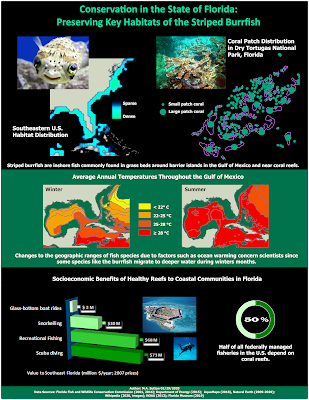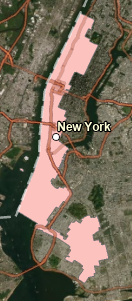Final Project [GIS6005]: Conservation in the State of Florida: Preserving Key Habitats of the Striped Burrfish
Striped burrfish are inshore fish
known to exploit a wide
range of depths. Although commonly found in grass beds around barrier islands in
the Gulf of Mexico (Franks et al., 1972), they are also found near coral reefs (Robins, Ray,
& Douglas, 1986), as well as in deeper waters during the winter months
(Audubon Society, 2002).
Changes
to the geographic ranges of fish species due to factors such as ocean warming
(Espino et al., 2019) are of concern to scientists. In addition, impacts to
fish habitats in tourism-based states such as Florida are considered by economists
given the socioeconomic benefits of commercial and recreational fishing to
coastal communities (Lellis-Dibble, McGlynn, & Bigford, 2008). As one
example of their impact, half of all federally managed fisheries in the U.S.
depend on coral reefs (Burton, 2019). In addition, the total value of coral reefs for southeast Florida was estimated
in 2007 to be $174 million/year (Brander & van Beukering, 2013), across the
ecosystem services of scuba diving ($73M), recreational fishing ($68M),
snorkeling ($30M), and glass-bottom boat rides ($3M).
The
goal of this project was to create an infographic (1) highlighting preferred habitat
regions of the striped burffish around the State of Florida and (2) promoting
the conservation of these areas.
References
Audubon Society. (2002). In C. R.
Gilbert & J. D. Williams (Eds.), National
Audubon Society: Field guide to fishes. (pp. 576-577). New York, New York:
Alfred A. Knopf, Inc.
Brander, L., & van Beukering, P.
(2013). The total economic value of U.S.
coral reefs: A review of the literature. Silver Spring, MD: NOAA Coral Reef
Conservation Program.
Burton, R. (2019). Coral reefs are in trouble: Here’s how you can help. Gainesville,
FL: Florida Museum.
Espino,
F., Tuya, F., del Rosario, A., Bosch, N. E., Coca, J., González-Ramos, A. J.,
... & Haroun, R. (2019). Geographical range extension of the spotfin
burrfish, Chilomycterus reticulatus
(L. 1758), in the Canary Islands: A response to ocean warming? Diversity, 11(12),
230.
Franks,
J. S., Christmas, J. Y., Siler, W. L.,
Combs, R., Waller, R., & Burns, C. (1972). A study of nektonic and benthic
faunas of the shallow Gulf of Mexico off the state of Mississippi as related to
some physical, chemical and geological factors. Gulf Research Reports, 4(1), 127.
Lellis-Dibble,
K. A., McGlynn, K. E., & Bigford, T. E. (2008). Estuarine fish and shellfish species in U.S. commercial and
recreational fisheries: Economic value as an incentive to protect and restore
estuarine habitat. Silver Spring, Maryland: NOAA/NMFS, Office of Habitat
Protection.
Robins, C. R., Ray, G. C., &
Douglass, J. (1986). A field guide to
Atlantic coast fishes of North America. (pp. 309). Boston, Massachusetts:
Houghton Mifflin.




Comments
Post a Comment